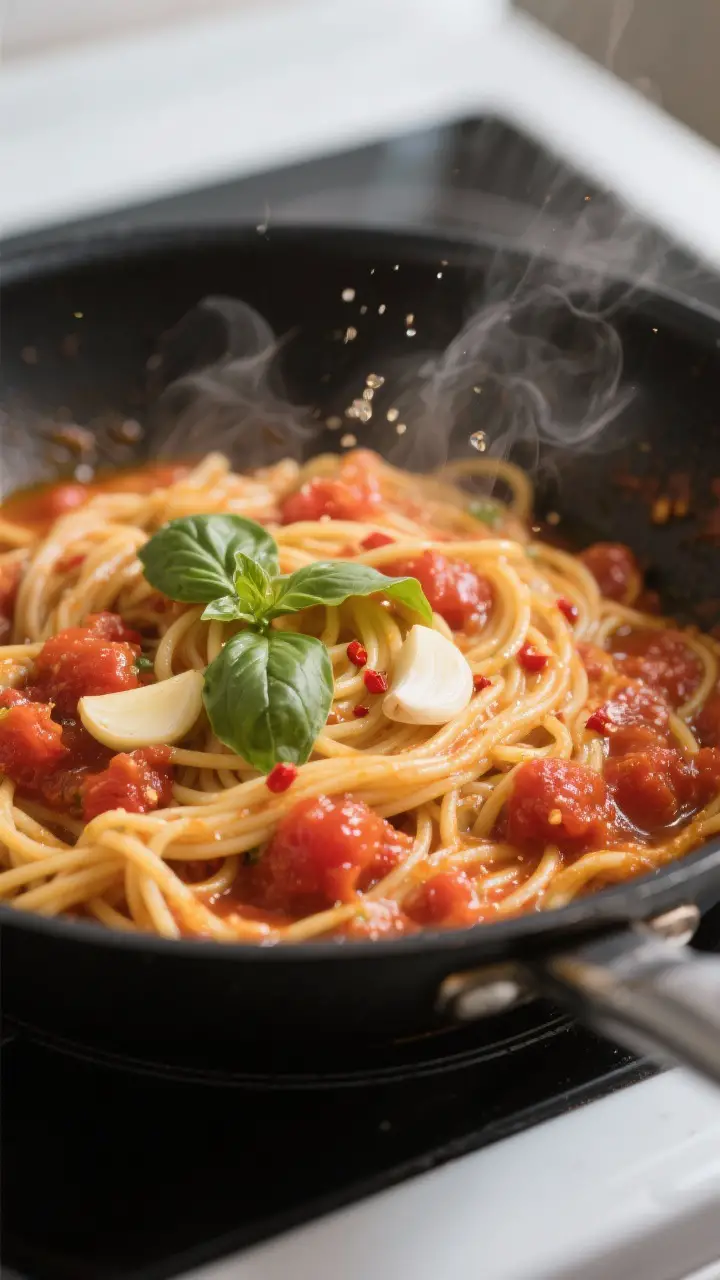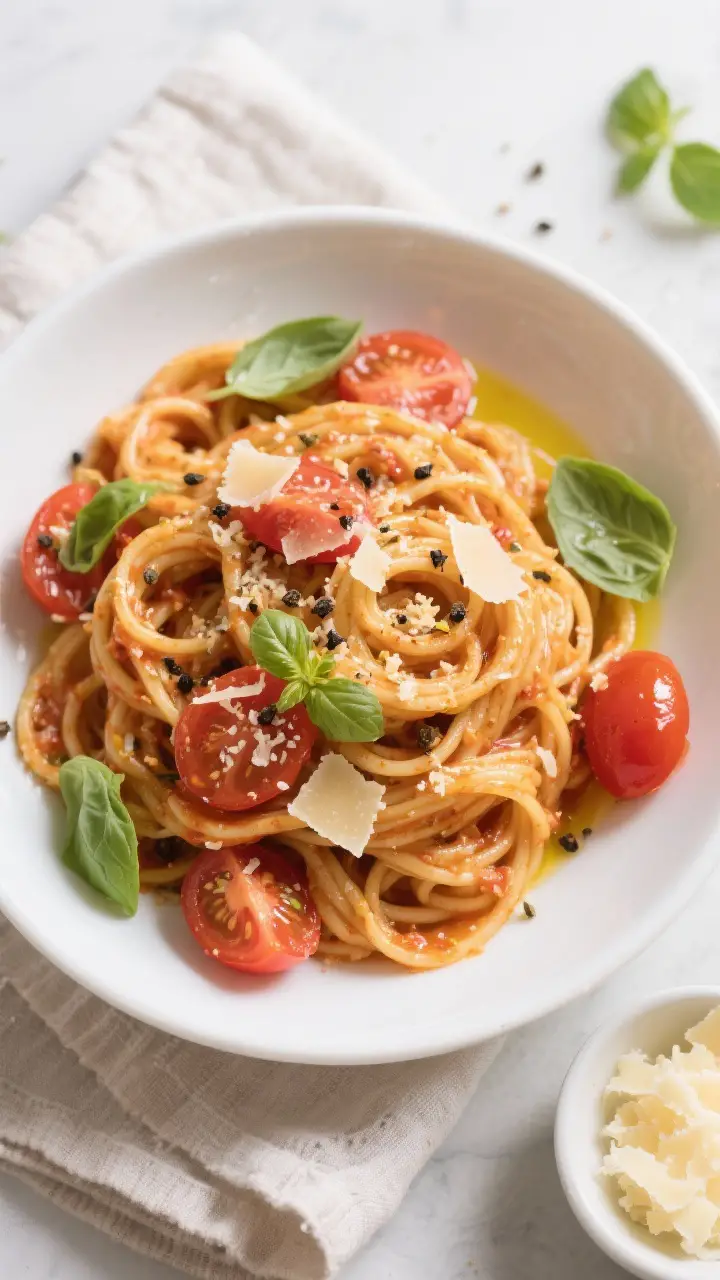Tomato Basil Pasta is one of those meals that tastes like summer in a bowl. It’s fast, fresh, and doesn’t need much more than ripe tomatoes, fragrant basil, and good olive oil. The sauce comes together while the pasta cooks, which makes this perfect for weeknights.
You get a clean, vibrant flavor without heavy cream or long simmering. If you love simple food that still feels special, this is your go-to recipe.
What Makes This Special

This recipe is all about fresh ingredients. When tomatoes, basil, garlic, and olive oil are at their best, you don’t need much else.
The result is a sauce that’s light yet full of flavor. It coats the pasta instead of drowning it, so every bite tastes balanced and bright.
It’s also quick and adaptable. You can keep it classic or add a few extras without complicating the process.
The technique is straightforward, and the payoff is big: a restaurant-worthy bowl of pasta at home, with minimal effort.
Ingredients
- 12 ounces pasta (spaghetti, linguine, or bucatini)
- 1 1/2 pounds ripe tomatoes (cherry, grape, or vine-ripened), chopped
- 3–4 cloves garlic, thinly sliced
- 1/4 cup extra-virgin olive oil, plus more for finishing
- 1/2 teaspoon red pepper flakes (optional, adjust to taste)
- 1 teaspoon kosher salt, plus more for pasta water
- Freshly ground black pepper, to taste
- 1 loosely packed cup fresh basil leaves, torn
- 1–2 tablespoons unsalted butter (optional, for gloss and body)
- 1/2 cup grated Parmesan or Pecorino Romano, plus more for serving
- 1 teaspoon lemon zest or a squeeze of lemon juice (optional, for brightness)
How to Make It

- Salt the water well. Bring a large pot of water to a rolling boil. Add enough salt so it tastes like the sea. This is your first chance to season the pasta from within.
- Prep the tomatoes and basil. Halve or chop tomatoes into bite-size pieces.
Tear the basil by hand to avoid bruising. Slice the garlic thin so it gently infuses the oil.
- Start the pasta. Add pasta to the boiling water and cook until just shy of al dente, usually 1 minute less than package instructions. Reserve 1 cup of the starchy pasta water before draining.
- Sauté the garlic. While the pasta cooks, warm olive oil in a large skillet over medium heat.
Add garlic and red pepper flakes. Cook 30–60 seconds until fragrant, not browned. If it browns, start over; burned garlic turns bitter.
- Build the fresh sauce. Add the chopped tomatoes and 1 teaspoon salt to the skillet.
Cook 3–5 minutes, stirring, until tomatoes soften and release their juices but still hold some shape. You’re aiming for a chunky, juicy sauce, not a long simmer.
- Combine pasta and sauce. Add the drained pasta to the skillet with a splash of reserved pasta water. Toss vigorously over medium heat.
The starch will help the sauce cling.
- Finish with basil and richness. Off the heat, add the torn basil, butter (if using), and cheese. Toss until glossy. Adjust with more pasta water if it looks dry.
- Season and brighten. Add black pepper and, if you like, a touch of lemon zest or juice.
Taste and adjust salt.
- Serve immediately. Drizzle with a little more olive oil and shower with extra cheese. Eat while it’s hot and aromatic.
How to Store
Tomato Basil Pasta is best fresh, but leftovers can work. Store in an airtight container in the fridge for up to 2 days.
Reheat gently in a skillet with a splash of water or olive oil to loosen the sauce. Add a few fresh basil leaves before serving to revive the flavor.
Freezing isn’t ideal because fresh tomatoes and basil lose their texture and brightness. If you do freeze, skip the basil and cheese, and add them fresh after reheating.

Why This is Good for You
- Fresh tomatoes deliver vitamin C, potassium, and lycopene, an antioxidant tied to heart health.
- Basil offers plant compounds that may support healthy inflammation and digestion.
- Olive oil provides heart-healthy fats that help your body absorb fat-soluble nutrients.
- Moderate portions of pasta offer steady energy, especially if you choose whole-wheat or higher-fiber options.
It’s a meal that feels light yet satisfying, relying on real, simple foods instead of heavy sauces.
What Not to Do
- Don’t overcook the garlic. It should be aromatic and pale, not brown.
Burnt garlic will dominate the dish.
- Don’t skip salting the water. Underseasoned pasta tastes flat no matter how good the sauce is.
- Don’t over-reduce the tomatoes. You want fresh, juicy brightness, not a thick stew.
- Don’t add basil too early. High heat dulls its flavor. Fold it in at the end.
- Don’t forget pasta water. The starch is your natural thickener and creates a silky coating.
Recipe Variations
- Caprese Twist: Add fresh mozzarella pearls at the end. Let them soften in the warm pasta.
- Olive and Capers: Stir in chopped Kalamata olives and a spoon of capers for a briny kick.
- Roasted Tomato Upgrade: Roast cherry tomatoes with olive oil and salt at 425°F (220°C) for 15–20 minutes, then proceed.
Adds sweetness and depth.
- Garlicky Breadcrumbs: Toast panko with olive oil, garlic, and lemon zest. Sprinkle on top for crunch.
- Protein Boost: Add grilled shrimp, seared chicken, or a can of good-quality tuna packed in olive oil.
- Creamy Option: Stir in a splash of mascarpone or a dollop of ricotta off the heat for a silkier finish.
- Spicy Arrabbiata-Style: Increase red pepper flakes and add a spoonful of tomato paste for extra heat and body.
- Whole-Wheat or Gluten-Free: Use your favorite alternative pasta. Adjust cooking time and salt accordingly.
FAQ
Can I use canned tomatoes?
Yes, but the flavor will be different.
Choose high-quality whole peeled tomatoes and crush them by hand. Simmer just a few minutes to keep things light. Fresh tomatoes are ideal here, though, especially in season.
What type of tomatoes work best?
Ripe cherry or grape tomatoes are reliable year-round because they’re sweet and juicy.
In peak season, vine-ripened or heirloom tomatoes are excellent. If they’re very watery, seed some of them to keep the sauce concentrated.
Do I have to use butter?
No. The butter adds a subtle richness and helps the sauce cling, but you can skip it for a lighter or dairy-free version.
A little extra olive oil will still give you a glossy finish.
How do I keep the basil vibrant?
Fold it in off the heat and don’t chop it too fine. Tearing prevents bruising and keeps the oils intact. If you have extra, add a few fresh leaves right before serving.
What’s the best pasta shape for this?
Long noodles like spaghetti, linguine, or bucatini are classic.
Short shapes like penne or fusilli also work and catch the tomato bits nicely. Use what you have and adjust sauce-to-pasta ratio if needed.
Can I make it ahead?
You can prep the tomatoes and garlic a few hours in advance and store them in the fridge. Cook the pasta and finish the sauce right before serving.
This dish shines when everything is fresh and hot.
How do I make it less acidic?
Use very ripe tomatoes and finish with a knob of butter or a pinch of sugar. A light grate of Parmesan also balances acidity. Avoid long cooking, which can concentrate tartness.
Is this vegetarian?
Yes, as written with Parmesan.
For a fully vegetarian-friendly cheese, use one made without animal rennet, or try Pecorino-style alternatives. Skip cheese for vegan, or use a plant-based option.
In Conclusion
Tomato Basil Pasta proves that great food doesn’t need to be complicated. With ripe tomatoes, fresh basil, and good olive oil, you can put a beautiful meal on the table in under 30 minutes.
Keep the technique simple, season well, and finish with care. It’s fresh, flexible, and always satisfying—exactly what weeknight cooking should be.
Printable Recipe Card
Want just the essential recipe details without scrolling through the article? Get our printable recipe card with just the ingredients and instructions.

